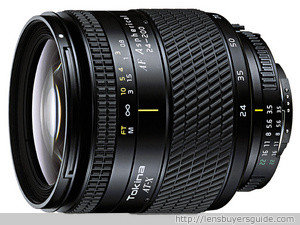Lens finder
Tokina AF24-200mm f/3.5-5.6
Full frame sized imageLenses that create APS-C sized image are designed for digital only. They cannot be used on cameras that have image sensor larger than the APS-C format. These lenses are not suitable for film cameras either. No Ultrasonic AFLenses with ultrasonic focusing mechanism tend to be quiter and faster than traditionally focusing lenses. No stepping motor AFLenses with stepping motor focusing mechanism are better for contrast based focusing, and are quiter and faster than traditionally focusing lenses. One or more Low Dispersion lens element is usedLow Dispersion lens elements help to reduce chromatic aberration. Not stabilizedImage stabilization helps to reduce blur caused by hand shake, especially at high focal length or in low light situations. Image stabilization can give 1 to 3 stop advantage over none stabilized lens, based on the reciprocal rule. Internal FocusingInternally focusing lenses don't change their size while setting focus. The front lens is fixedThe fixed front lens is not rotating during zoom and/or focusing. This allows the photographer to use petal shaped lens hood. Fixed front lenses also make the use of polarization filters a lot easier. No drop-in filter supportDrop-in filters are used in those lenses where either the front lens is too large, or the field of view doesn't permit the use of traditional filters at the front of the lens. Usually bright tele and ultra-wide angle lenses support this filter type. |
|
|
It is constructed using a chrome plated brass mount plate and a combination of aluminum and composite lens barrels to reduce weight while maintaining strength and durability. 242 uses high quality optical glass multicoated lens elements. Two Aspherical lens elements and one SD (super low dispersion) glass element are employed in the optical design to insure sharpness across the film plane. The aspherical elements are each molded as one piece of optical glass rather than a resin laminated to a glass core. An internal focusing mechanism gives this lens fast auto focus. Focus distance is indicated on the manual focus ring. Like the rest of the lenses in the AT-X series, The AT-X 242 AF is what is commonly referred to as a parafocal lens, meaning when focus is achieved at a telephoto focal length, it is possible to zoom back to a wide angle and maintain focus on the subject.
|
Tokina AF24-200mm f/3.5-5.6 Specification
| Available mount(s) | Canon EF, Nikon F, Pentax K, Sony / Minolta A |
| Application(s) | Portrait, Landscape, Interiors, Architecture |
| Category(s) | Wide angle zoom |
| Multiplier | 1× |
| Stabilizer | no |
| Focal length | 24 - 200 mm (8.30× zoom) |
| Lens construction | 15 elements in 13 groups |
| Angle of view |
35mm: 84.16-20.16° digital: N/A |
| Number of blades | 6 |
| Maximum aperture | wide: f/3.5 tele: f/5.6 |
| Minimum aperture | wide: f/22 tele: N/A |
| Minimum focusing distance | 80 cm |
| Magnification | 0.17× |
| Filter size | 72 mm |
| Size | ∅ 81.8 × 89 mm |
| Weight | 690 g |
| Notes |
|
| AF speed | N/A |
| AF sound | |
| Internal focusing | yes |
| Internal zoom | N/A |
| Fix front lens | yes |
| Mount type | N/A |
| Weather sealed | N/A |
| Drop in filter | no |
| Ultrasonic AF | no |
| Stepping motor AF | no |
| APS-C sized circle | no |
| Low dispersion lens element | yes |
| Hard case | N/A |
| Soft case | included |
| Lens hood |
included printable lens hood |
| Tripod adapter | N/A |
Tokina AF24-200mm f/3.5-5.6 Reviews
Other reviews
Tokina AF24-200mm f/3.5-5.6 in the news
- Tamron SP AF60mm f/2.0 Di-II Macro
- Nikkor AF-S DX 85mm f/3.5G ED Micro
- Carl Zeiss Distagon T* 35mm f/2.0 ZF
- Sony SAL2875 28-75mm f/2.8 SAM
- Carl Zeiss Distagon T* 28mm f/2 with EF mount
- Tamron SP AF17-50mm f/2.8 XR Di II VC LD Aspherical
- Carl Zeiss Distagon T* 2,8/21 for EF mount
- Carl Zeiss Distagon T* 3,5/18 ZE
- SIGMA 70-300mm F4-5.6 DG OS
- Nikkor AF-S 16-35mm f/4 G ED VR

